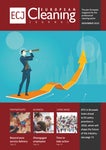Home › magazine › latest news › How to clean ergonomically and safely?
How to clean ergonomically and safely?
15th of May 2023That's the question being tackled by a new research programme being co-funded by Erasmus+, the EU funding programme for education, training, youth and sport in Europe.
Professional cleaning sector organisations from Estonia, Finland, Hungary and the Netherlands are taking part in the project - it will be focusing on physical, mental and organisational stress indicators in a bid to develop better training and guidance material.
The training organisation SVS is the Dutch partner and it has shared some of the results so far with ECJ - its representatives André de Reus, Lydia Huizinga and Frans Tijsse Klasen are involved.
Stress
In terms of stress factors, 93 per cent of the cleaning operatives surveyed - and 97 per cent of the managers - find the work they do meaningful. Although the majority say they are happy with their work, they do also experience some stress factors:
• Seventy per cent of cleaners indicate their profession is physically demanding
• Seven per cent of cleaners say they have no physical complaints at all
• Seventy per cent of supervisors describe their profession as mentally demanding
• In general, managers feel they have more influence over the work they do.
Efficient cleaning
Creating better working conditions for cleaners requires better cooperation with the users of the space being cleaned.
For example, 70 per cent of respondents said the number of items in a room hinders efficient cleaning. And the type of materials to be cleaned and their condition also contribute to whether or not they can be cleaned efficiently.
Employers are doing their best to improve the safety in their employees workspaces, but this alone is not enough - the research suggests.
Training and guidance
Professional skills and training play a big part in the ability to choose the best possible tools and methods in different situations.
A worrying finding is that one in five of the respondents did not have proper training or guidance on how to use a cleaning tool and how it should be applied in the most ergonomic way. Instructions and guidance on the safe use of cleaning machines were also not given to more than half of the respondents.
Workload on the body
Through motion sensors worn in a T-shirt and trousers, workload was measured on different parts of the body. One of the conclusions is that more pressure can be removed from the arms while cleaning, by using the power of the legs in the movements made.
Occupational illnesses and accidents
The results of the research show the most common occupational illnesses are pain in the lower back, wrist, arm and shoulder. Mental tension and stress among cleaners is also getting worse every year.
Based on the available results, the most common occupational accidents are: falls, strains, cuts from objects and falling over objects.
In each participating country, the survey for this particular study was sent to 10 organisations. A total of 267 cleaners and 147 managers completed it.










